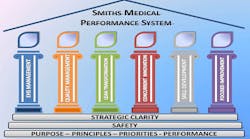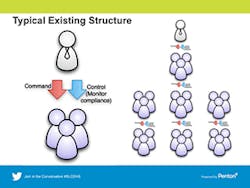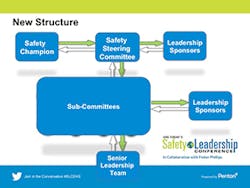What does it take to become one of the best?
This session at the 2016 Safety Leadership Conference in Pittsburgh examined what sets three previous America's Safest Companies winners apart from the crowd in their industries, and discussed their efforts to achieve safety culture leadership.
Tim McGraw, vice president of global EHS, security and facilities, and Stacey Simmons, a continuous improvement specialist at a Smiths Medical facility in Dublin, Ohio, shared an overview of the safety performance system (SPS) at Smiths Medical that encourages frontline associates to own and lead the safety process.
McGraw offered the bird’s eye, corporate perspective of the system, while Simmons was able to share her “boots on the ground” experience implementing the program.
McGraw offered an overview of the system, which is based on the Milliken model, in which self-directed work teams manage safety processes/programs through a series of training & skill building exercises. The system is designed to build:
- Engagement
- Empowerment and accountability
- Teamwork
- Problem solvers
Although safety is the foundation, the SPS includes additional pillars such as quality, Lean and continuous improvement. McGraw said the essential elements of the program are:
- Leadership commitment at all levels
- An EHS Strategic Plan from 2010 forward
- An engaged safety culture - SPS
- Effective communications
- Recognition leader
- Simple metrics (use of leading indicators)
- Talented global staff
- Strong compliance foundation with streamlined policies and procedures (and audit)
- Empowered sites
- Collaborative approach including EHS goals.
Simmons, who directs the process at the Dublin facility, said it took about one year to develop the site Safety Steering Committee, which initially had nine members who met monthly for one and a half- to two-day sessions until the program got off the ground.
The “typical” existing structure was a command and control structure – focused on compliance – that directed safety from the top down, she noted, with the plant manager or other leader directing managers who direct supervisors who direct employees. The new structure has sub-committees which promote two-way communication between the safety steering committee, the senior leadership team, leadership sponsors and the safety champion (typically the safety director).
Benefits of the program at the site level included higher morale among employees, because they feel like they are being engaged in the safety process. “People see the improvements and they want to be a part of that and see that it is changing our culture,” Simmons said.
According to McGraw, the three keys to success is that senior managers must be patient, front line supervisors must let go and allow the program to function as it should and front line employees must step up and participate
As with many companies, many different safety process improvements and programs have been tried over the years, but this is the one that has captured employees’ and management’s interest. As McGraw noted, “This is not a flavor of the month.”
The company invested heavily in the SPS, both in terms of funding and resources.
Although, as Simmons noted, “Three and a half years later, we’re still trying to convince them that this program isn’t going anywhere.”



